Perennial lobelia: varieties, planting and care

Lobelia is a beautiful perennial flower that has not yet received mass distribution among domestic florists. Therefore, it's time to plant this plant in your area. After all, it will immediately become the main basis for the entire flower arrangement.
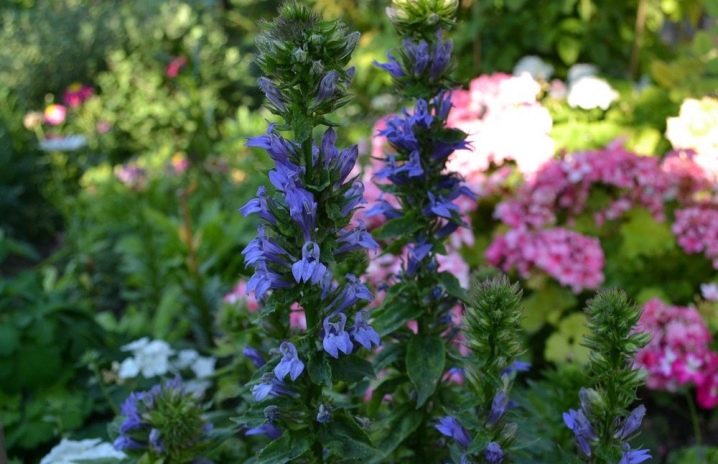
Short description
Lobelia is a beautiful herbaceous flower, the height of which does not exceed 120 cm. The assortment of varieties includes both bushy and ampelous plants. Branches are thin, numerous, with strong branching. They are abundantly covered with thin and delicate leaves.... Their color is light green, saturated, and their shape is elongated.

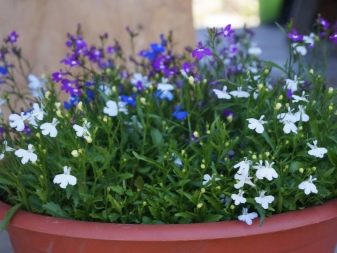
In the axils of the stems there are numerous small flowers of the most varied colors - from pale white to rich dark blue.
The whole lobelia is as if strewn with them. Flowering begins en masse, and this herb simply turns into a blooming bloom, like a weightless ball, which immediately attracts attention. The flowering period is all summer, and after its end, light boxes appear in place of the flowers, in which there are microscopic seeds.

Types and varieties
The variety of perennial lobelia varieties is quite large, you need to familiarize yourself with the main ones in order to make the right choice. It is worth clarifying here that in the harsh climatic latitudes of our country, some species of this perennial turn into annual plants. Therefore, resistance to low temperatures must be taken into account.
- Lobelia is beautiful Is a frost-hardy plant ideal for growing in cold climates. The flower is bushy, with a powerful and high stem. The flowers are large, rich burgundy color, and their size can exceed 3 cm in diameter. The height of the bush itself can reach 100 cm. The advantage of this type of lobelia is that it can be grown both as a perennial and as an annual flower.

- Red perennial lobelia Is an ideal plant for decorating flower beds and lawns. It has not only large bright red flowers - in some plants the leaves themselves are painted in the same color. The height of the bush can range from 90 to 150 cm. The leaves are small, delicate, bright green. The variety is relatively frost-resistant, therefore, it is still recommended to cover this flower for the winter.
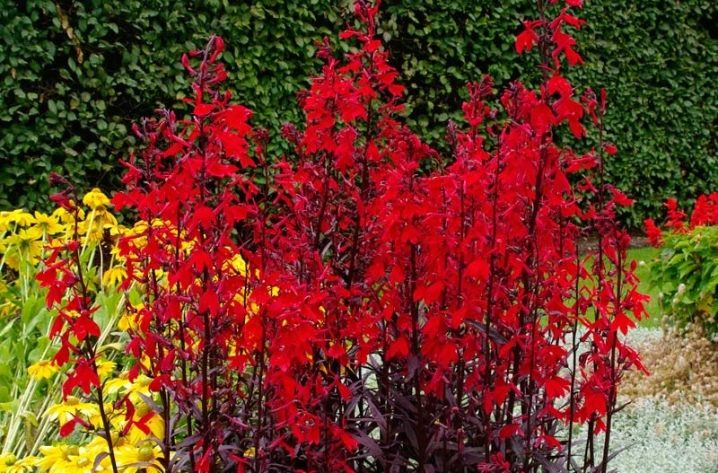
- Lobelia purple or cardinal Is another perennial species. It has rather high erect stems, the height of which may slightly exceed 100 cm. Lobelia inflorescences are presented in the form of lush spikelets, and their color is rich, bright purple. He loves water very much, therefore it is necessary to plant it near water bodies or alpine slides.
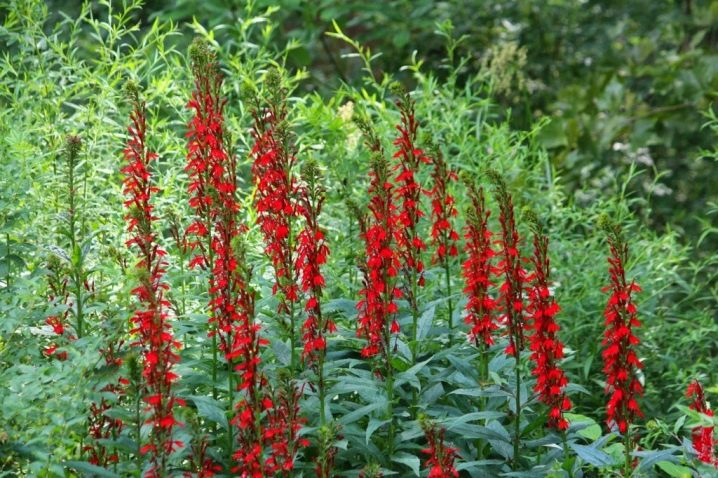
- "Bird home" Is the most decorative, attractive and delicate lobelia variety. The inflorescences are presented in the form of small spikelets, the color of the flowers is bright blue, saturated. The leaves are small, bright green. This type of plant can be considered ampelous. It does not differ in great frost resistance, therefore, it needs shelter in the cold season. The height of the stems does not exceed 25 cm, but the bush is very branchy and has a spherical shape.

- Lobelia "Blue River" has a second name - "Syphilitic". The height of the bush, as a rule, reaches 70 cm, the whole plant is covered with a scattering of compact dark blue flowers, up to 2 cm in diameter.
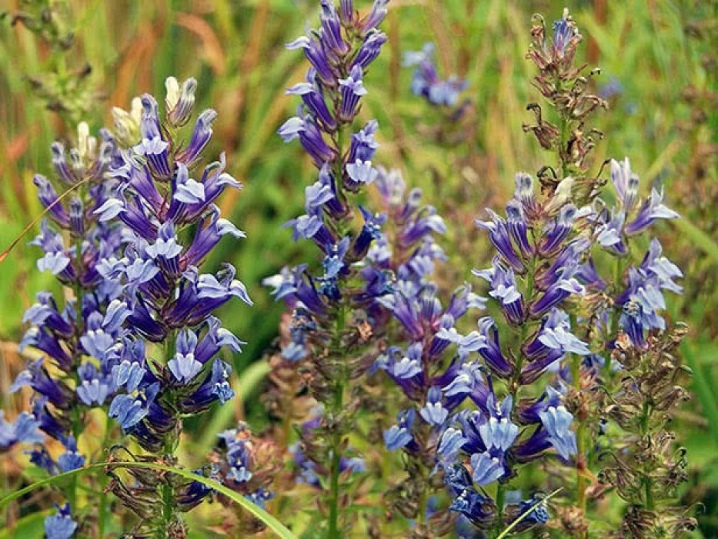
- Lobelia Dortman listed in the Red Book. It is a low herbaceous plant with a low level of bushiness.Flowers are small, color from white to pale blue. This flower prefers sandy soils and grows best directly near water bodies.
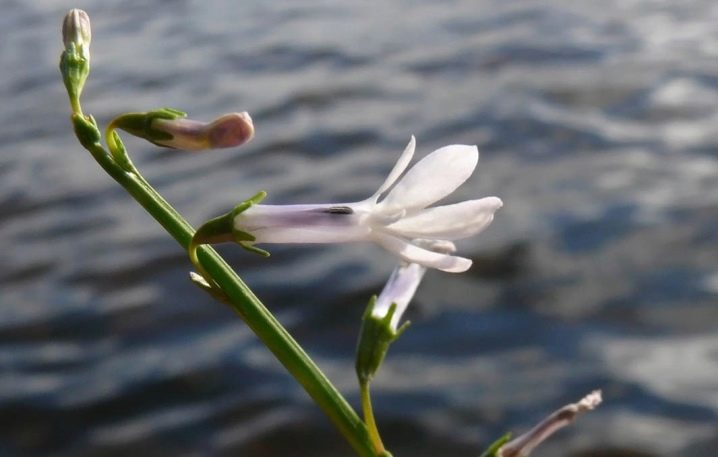
- Lobelia "Gerardi" characterized by increased frost resistance. Even at temperatures below 30 degrees, it does not need shelter. The main stem is high - up to 90 cm, the flowers are collected in massive spikelets, the color of which is always dark and rich - purple or violet.

Such a wide variety of varieties of this flower allows you to choose the best option for decorating flower beds in any garden and on any site. But it is not enough just to choose the desired variety, it is also necessary to grow it correctly.
Landing
Sowing seeds is considered to be the most laborious, but at the same time interesting. And here stands take into account some features.
- Lobelia grows very slowly. Therefore, the sowing of the material is carried out from the beginning of February to the second decade of March.
- It is best to use a special soil for planting, which contains coconut fibers and river sand.
- The seeds are not tamped, but because of their small size, they are mixed with ordinary river sand before sowing.
- If the planting of lobelia for seedlings is carried out in February, then it is imperative to use additional lighting in the form of phytolamps.
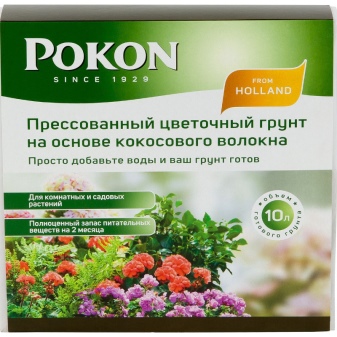
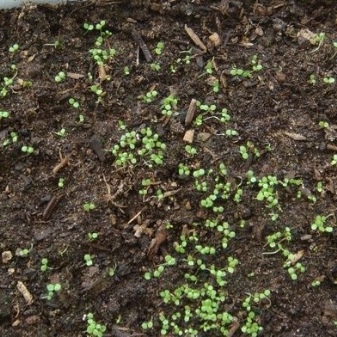
And yet - lobelia seeds, like many other flowers, can be planted in peat tablets and special containers. The sequence of actions in this case will be slightly different, so it is necessary to study both methods in detail in order to avoid mistakes.
In peat tablets
First of all, you should prepare a wide container with a pallet and yourself pills:
- we place peat blanks in the chosen container and fill them with warm water;
- after 15 minutes, pour out the excess liquid, and spray the surface of the tablets from the spray on top;
- using a toothpick, lay out the seeds - up to 4 pieces per peat blank;
- spray the seeds from the top with a spray bottle and cover them with a film or a container lid.
Now we remove the container with crops in a warm place with a temperature of about 25 degrees above zero and leave for three weeks. Periodically - about 2 times a week, the seeds should be sprayed with warm water.

Into the ground
Here you should use a ready-made substrate, which is placed in containers with a layer of about 5-10 cm and watered. The seeds themselves are mixed with clean and disinfected sand in a ratio of 1: 1.
Now we scatter the seed in grooves on the surface of the soil and spray it again from above. We cover the container with a lid or foil, and put it in a warm place. About once a week, crops should be sprayed with warm water and condensation removed from the cover or film. The first shoots should appear after 7-10 days.
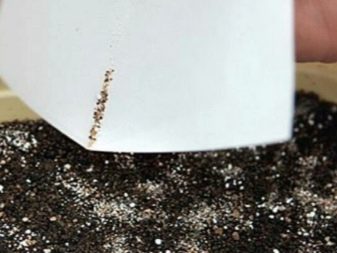

And after three weeks, the seedlings will have the first three leaves, and it will be necessary to pick.
To do this, prepare one container for each lobelia bush, with a volume of about 500 ml, and fill it with soil. We do not use drainage. We water the substrate with water and plant one plant at a time. When the flower has the first five leaves, we carry out the first pinching. Thus, in the future, the lobelia will be lush and intensely blooming.

Care
In open ground, dived seedlings are planted in the first decade of June. Despite the fact that this plant is frost-hardy, young seedlings should still be protected from frost. For planting, you need to choose a sunny place with loose and light earth - only in this way the flower will grow healthy.
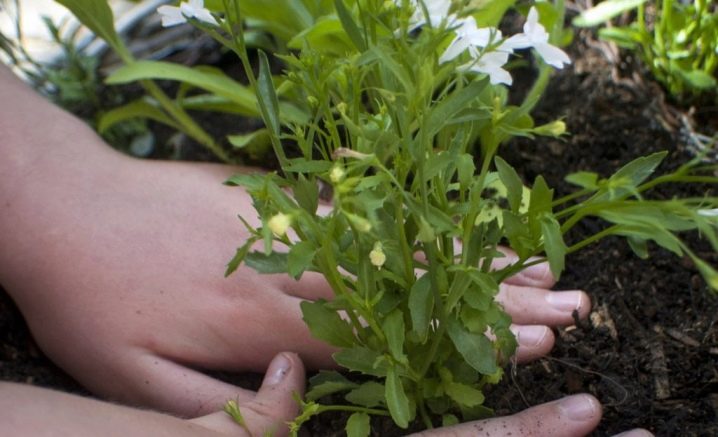
It is necessary to avoid the presence of a large shade - in this case, the flowering will be weak, and the lobelia stalks themselves will turn out to be too long and thin.
Flowers are planted in pits about 2-3 cm deep, at the bottom of which a drainage layer of pebbles of 1 cm is made. In addition, other rules should be followed.
- During the active flowering phase, lobelia should be watered regularly and abundantly.
- It is necessary to constantly remove not only the weeds around this plant, but also carefully loosen the soil. Otherwise, a crust forms on the surface of the soil, due to which the growth of the flower will slow down.
- Once during the entire flowering period, it is necessary to feed the lobelia with mineral fertilizer.
- You need to regularly pinch the plant for its better growth, as well as remove the inflorescences that have begun to dry out. So the bush will be lush and constantly blooming.
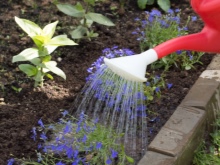
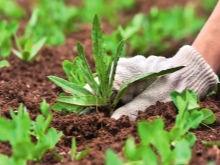
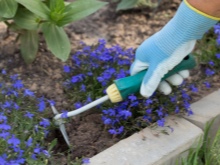
In the last months of autumn, it is necessary to cut the stems of lobelia at the very root and sprinkle their surface with a small amount of peat and dry leaves. If the winters are too harsh, then you must either use a special covering material, which is removed in spring, or, in general, transplant the root into a pot and send it to the greenhouse.
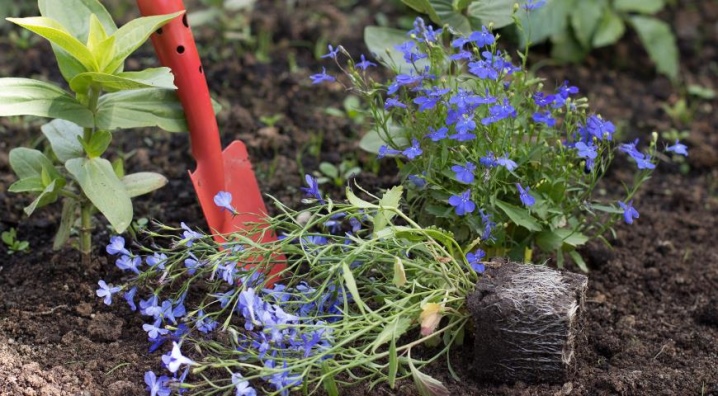
By and large, caring for this flower is not so difficult. The main thing is to regularly perform all these manipulations, and then the lobelia will only delight with its healthy, beautiful and blooming appearance.
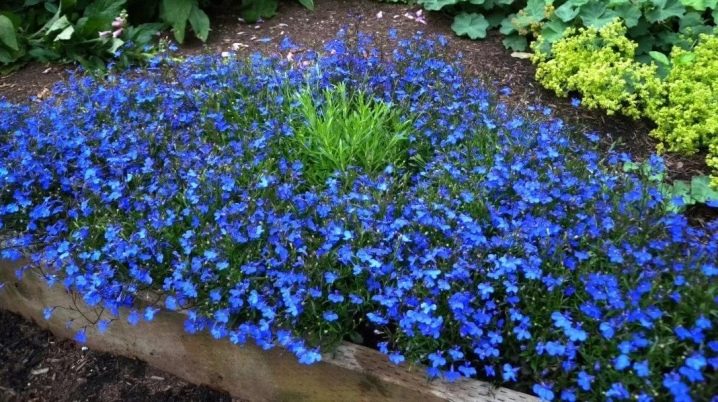
Reproduction
You can grow lobelia or increase its number on your site by cuttings or just dividing the bush.
- In the case of dividing the bush, in the spring, the flower is dug up, its roots are divided into several separate bushes and transplanted to a new place. For better rooting, you can use special growth and root stimulants. This method of planting a new plant is called vegetation or vegetative propagation.
- Planting cuttings is carried out as follows: in late autumn, the strongest stem of lobelia is broken off, and it is planted in a spacious container with a loose peat-sandy substrate. Leave until spring in a warm place, making sure that the soil does not dry out. In early spring, cuttings are planted in a permanent place of growth.


After transplanting to a permanent place, plant care is the same as described above.
Pests and diseases
Lobelia is a plant that is quite resistant to negative external influences. But sometimes and its owners have to face problems.
- Decay of roots. This problem arises for only one reason - excessive soil moisture. Watering should be done less frequently and less water should be used. If necessary, it is better to transplant the flower to a new location.
- Rust, powdery mildew, rot - all these ailments are also a sign of excessive watering. The damaged parts of the lobelia are cut at the root, and the watering is made less intense and more rare.
- Mosaic - This is a rare but extremely dangerous disease. Lobelia leaves are covered with spots of different colors: red, brown or even crimson. The cause of infection is the presence of fungus in the soil or water. Such flowers are simply dug up and burned, since it is impossible to cure them.

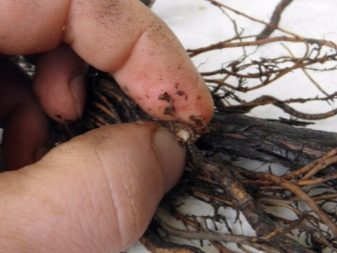
There are also three types of pests, the invasion of which brings a lot of trouble to the owners of this flower.
- Spider mite. Signs of its appearance are a thin cobweb entangling inflorescences and leaves, as well as drooping stems of the flower itself. First, the plants are sprayed with an aqueous extract of dry tobacco or garlic. If this does not help, then it is necessary to purchase a special acaricidal preparation.
- Slugs damage the roots, stems and leaves of lobelia. They are very fond of moisture, like the flower itself. It is very simple to scare them away - small bowls with water, to which chlorine is added, are placed around the bushes. It is its unpleasant smell that will scare away these pests. The damaged parts of the plant are simply cut off.
- Aphid causes the leaves of lobelia to roll up into a tube, interferes with active flowering, and, as a result, can cause it to wilt. It is very easy to save a flower - it is sprayed with a simple solution of water and laundry soap twice a week.
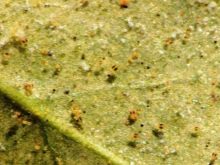
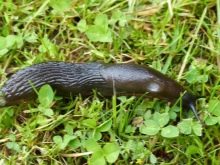

Perennial Lobelia is a plant ideal for bringing freshness, beauty and novelty to any area. There are no particular difficulties in planting and further cultivation.
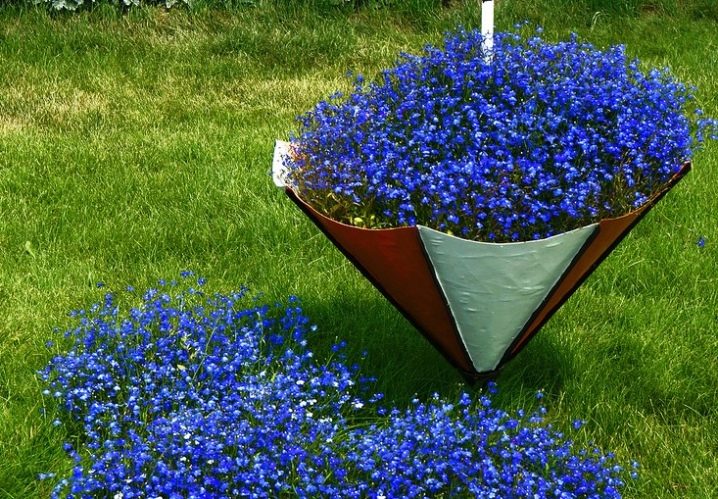
The main thing is to strictly follow all the recommendations, and then Lobelia will show you all its beauty.
For more information on perennial lobelia, see the video below.





































































































The comment was sent successfully.